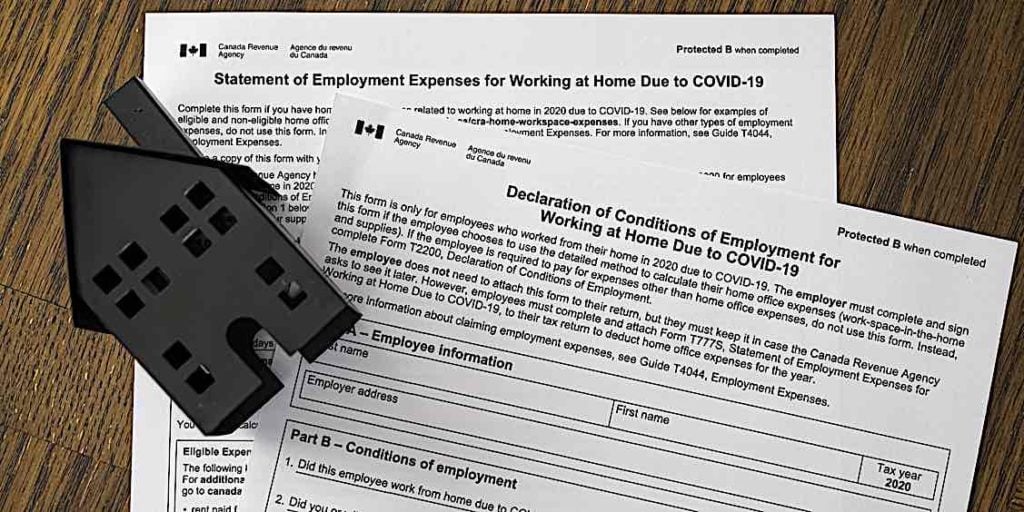
CRA provides updated guidance for employees deducting work-from-home expenses in 2021 & 2022
Employers can help employees in understanding “work-from-home” expenses, by ensuring that their team members are aware of the CRA’s updated guidance for deducting work-from-home expenses in 2021 and 2022.
Disclaimer: Please note, that this is for the purposes of helpful information. Please contact us (form below), or your tax expert or the CRA for detailed information.
Background
Prior to the pandemic, employees who wanted to claim work-from-home expenses were required to keep a detailed log of their eligible expenses, and obtain form T2200: Declaration of Conditions of Employment from their employer.
Due to the unprecedented volume of employees working from home due to the pandemic, in December 2020 the CRA introduced a temporary $2/day flat-rate method that allowed employees to claim up to $400 in work-from-home expenses, but without having to keep receipts or records.
New from CRA
The CRA has announced that for both the 2021 and 2022 tax years, employees who work from home at least 50 percent of the time over a period of a least four consecutive weeks due to the pandemic, can now claim up to $500 in expenses per the previously-introduced $2/day flat-rate method. The maximum number of eligible days in 2021 in 2022 is 250 (up from 200 in 2020).

Example: Jane the Accountant
Prior to the pandemic, Jane worked as an accountant in a corporate office. In 2021, due to the pandemic she worked from home for 197 days. In her 2021 tax return, she can claim a deduction of $394 in work-from-home expenses (192 x $2).
Note that this is a deduction and not a credit. Jane’s tax refund will not increase by $394, or her tax bill will not decrease by $394. The exact benefit to Jane (either in the form of a bigger refund or smaller bill) will be determined by her respective tax bracket. For example, if Jane is in a 30% tax bracket, then the $394 work-from-home expense deduction will equate to a reduced tax obligation of $118 ($394 x .30).
Example: Bill the Trainer
Prior to the pandemic, Bill worked as a corporate trainer on-site at various client locations. In 2021, due to the pandemic, he worked from home for 305 days. In his 2021 tax return, he can claim a deduction of $500 in work-from-home expenses (250 x $2).
Why is Bill only allowed to claim a $500 deduction instead of a $610 ($305 x $2) deduction? Because the maximum number of work-from-home days employees can claim in 2021 and 2022 is 250.

Detailed Method Still Available
Employees are not obligated to use the simplified $2/day flat-rate method for calculating their work-from-home deduction. If they wish, they can use the conventional detailed method if their eligible expenses are significantly higher than the $500 maximum allowed under the simplified method (we say “significantly higher,” because the administrative burden associated with the detailed method may not be worthwhile for employees unless the difference is meaningful — however, employees are free to choose either method).
For 2021 and 2022, the CRA has expanded the list of eligible expenses to include home internet fees. A comprehensive list of all eligible expenses is available here.
In addition, to claim the work-from-home deduction under the detailed method, employees must:
- Principally (i.e. at least 50 percent of the time) perform their job at home, or use their home office exclusively for earning income and for meeting with customers on a regular or continuous basis.
- Obtain from their employer a signed form T2200: Declaration of Conditions of Employment.
- Submit form T777: Statement of Employment Expenses.
Reimbursement for Additional Expenses
The CRA also announced that employees may be reimbursed by their employer for up to $500 in costs related to computer equipment, office chairs and other eligible expenses related to working from home due to the pandemic from March 15, 2020 through December 31, 2021. The $500 is cumulative and covers all eligible expenses (i.e. employees cannot claim up to $500 per expense or purchase — it is a total of $500).
Employees must provide receipts to their employer. The CRA will not view the reimbursement as a taxable benefit to the employee (i.e. the employee will not have to treat the reimbursement as a source of income and therefore pay taxes on it). More information is available on the CRA website.
mini contact


 Our HR solutions experts can recommend the right mix of HR outsourced services to make your entry into Canada easier.
Our HR solutions experts can recommend the right mix of HR outsourced services to make your entry into Canada easier.  Pivotal Employment Management Services co-hires your workforce, simplifying entry of your business in Canada.
Pivotal Employment Management Services co-hires your workforce, simplifying entry of your business in Canada. 















